-
Posts
4,730 -
Joined
-
Last visited
-
Days Won
7
Content Type
Profiles
Forums
Blogs
Gallery
Events
Store
Posts posted by Gordon Craig
-
-
Mike,
Thanks for posting the pages from Bender's book. I am due for a visit to "The House Of Terror" on Andrasi ut and will move that up on my list of things to do soon. Since this address, 60 Andrasi, was the headquarters of the Arrow Cross before it became the headquarters of the AVH they might have some pictures showing this armband in wear.
Regards,
Gordon
0 -
Ulsterman,
The website you posted is the one I refered to in my post. No guarantee that this medal is correct for that period but another piece of information. Send me Ms Koltai's phone number and email address and I'll contact her for you. Your interest in Red Cross medals has sparked my interest. In any countries military that I study I eventually get interested in the civilian uniforms. The military uniforms and medals etc. reflect the country but the civilian uniforms tend to do so even more so.
In Hungary there is little to nothing known about civilian uniforms of the Communist era. To my sensabilities that is like waving a red flag in front of a bull. I just cannot resist a challenge and need to research those uniforms. I've already started on the firemen and Finance/Customs Guards uniforms and I hope I can move onto the the Parilamentary Guard soon. The Military Museum has one Postal uniform and that is it.
Cheers,
Gordon
0 -
Gents,
It would be interesting to see one of these worn on a uniform. I am also curious as to why the crown is present on an Arrow Cross arm band. Here is a picture of the Arrow Cross insignia arm band being worn by Hungarian Officers shortly after the success of Operation MARGARETHE.
Regards,
Gordon

 0
0 -
Hunyadi,
This must be your "Christmas Present". I'll have to have a look at it some day. Especially the Rakoci era photos.
Cheers,
Gordon
0 -
Charles,
Interesting stuff. Last Wednesday was certinly productive! I wish now that I had of stayed with you! I am off to the Museum again tomorrow. Have to shoot some pictures of two Communist era Para badges. One from my colection and one from the mueums that lives in Tama's office. I think I will pay avisit to the library myself just to look arond and see if the photocopier has arrived yet!
Regards,
Gordon
0 -
Ulsterman,
Thanks for your contribution. I was going to post much more after the ribbons but had so much trouble posting the ribbons that I quit in frustration!!!!!!!!!!!!!!. The post Communist era ribbon charts I have do not show Red Cross ribbons but if you compare the red ribbon with the Hungarian colours on it on the ribbon chart to the 100 medal mentioned by Ulsterman they are the same ribbon.
Now back to where I was going to go originally, or at least I hope so. The next picture is of a J? MUNK?ERT or Good Worker badge from the Communist era. I have a Good Worker badge which I beleive is from the post Communist era and is of a completely different design. The little round badge posted next is also listed on a web site as being from the communist era but there is no proof of that. I will also post a picture of a cased KIV?LO V?RADO Excellent Blood Donor badge that is listed on at least one internet site as being from the Communist era.
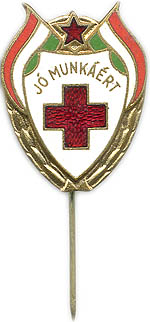
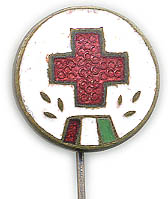



 0
0 -
Gents,
There seems to be enough interest in this one class of award that I thought I would start a thread on them alone. If we leave it in the "Hungarian Peoples Republic Awards" I think it will be too difficult to search through all of the other posts and put all of the relavent material together. I am going to start with Hunyadi's post that he translated from "The Book" and then post some pictures, some of which will raise questions and hopefully create some answers as well. When Ulsterman receives the things he is waiting for from the Hungarian Red Cross perhaps we can sort the whole range of awards, stick pins etc. out.
Excelent Blood Donner - Kivalo Verado
Bronze class 10 donations, Silver 15, Gold 20. Every year there were about 1300 gold ,about 2500 silver and 10,000 bronze distributed. Bronze came with 500ft prize, Silver 1000 ft and gold 1500 ft. After 30 blood donations the ribbon was switched to a green color and this was awarded to about 400 people per year. after 40 a blue ribbon (about 100 people per year) and 50 a yellow ribbon (about 50 people per year were awarded.) No mention as to when the award was created or what color the ribbon was for the Bronze, Silver and Gold class below 20 donations (? - perhaps it was only a badge??).
Excelent Blood Donor Technician Badge - Kivalo Veradoszervezo
For service in the field of the Red Cross as a worker in the blood donation centers and activities. The badge was awarded after five years of service. The badge was insituted in 1975.
Execlent Work in the Red Cross Badge - Voroskeresztes Munkaert Gold, Silver and Bronze classes. Awarded by the Leadeship Council of the Hungarian Red Cross for exemplarary service in the Hungarian Red Cross. Bronze class awarded after 5 years of serivce and came with a 1500 huf award and was awarded to about 250 people per year. Silver class for 10 years of serivce, a 2000 huf award and about 150 individuals per year. Gold class was for more than 10 years of service, but could also be bestowed for a certain meritiorious work. Came with a 3000 huf bonus and about 120 people were awarded per year.
Excelent Red Cross Workers Badge - Voroskereszt Kivalo Dolgozoja
Awarded by the Leadership Council of the Hungarian Red Cross for distinguised work over a period of time concering the technical operations of the Red Cross (machines, equipment, etc...) The award was bestowed about 10 times per year and the recipient received a 1500 huf bonus.
As for cases - Red and Deep Wine Red (Order of Labor, Order of Hungarian Freedom, and April 4th Order) for state awards. Blue and Gray are seen for Red Cross and Firemans awards. For the commemorative Red Cross awards (100 years in Hungary for example) these came in a sand brown case.
Here is a copy of part of a ribbon chart from the web. I can not guarantee its authenticity but I think it will prove interesting.
Gordon
0 -
Robin,
Did the site you found these pictures on identify where the pictures were taken?
Regards,
Gordon
0 -
Ian,
Thanks for straightening me out on that. A mistake on my part.
Regards,
Gordon
0 -
Theodor,
Thanks very much for taking the time to do all of this work. I have an interest in Bulgarian uniforms, among others, and it is nice to know the names of at least some of the pins that could be found on them.
Regards,
Gordon
0 -
Grant,
The DDR used the standard Russian Dragunov. They did not produce their own version of this rifle as some WP countries did.
Regards,
Gordon
0 -
Kevin,
Thanks for the suggestion. I would suspect Csepel Island would be a good bet. It is on the outstirts of the city and has been an industrial area for a long time.
Cheers,
Gordon
0 -
Nico,
I visited the sites you mentioned and they were very interesting. Particularly the one Marine one showing subs. Makes the badge I asked about even more interesting as that site indicated that U40 was built in Budapest where I live. Now I wonder where in Budapest it would have been built?
Regards,
Gordon
0 -
Gents,
Time to add some more photos from Soyuz 36. First will be Farkas in his space suit. Next in line will be the back-up crew in their suits. Finally, Farkas wieghtless in space.
Regards,
Gordon
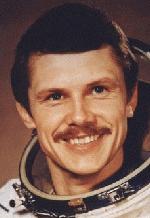
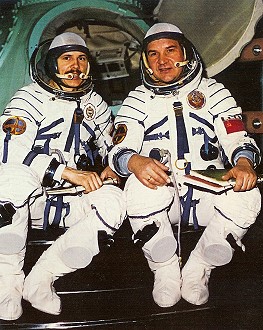
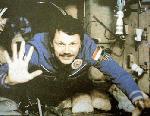








 0
0 -
Theodor,
I agree that in the future these readily available Communist era badges will eventually be harder to find and will go up in price. For this reason, I have started to pick up a lot of the small Hungarian badges. There is a wide variety and even now some of the organizations they represent are getting hard to identify. Would you like to tell us what some of these badges were for or what organization they were from?
Regards,
Gordon
0 -
Carol 1,
Great post! It would be interesting if we could have a post for all of the Cosmonauts who flew in the Intercosmos series. I know the the DDR, North Viet Nam, Hungary and Rumania took part in Intercosmos flights. Anyone else know who the other participating countries were?
Regards,
Gordon
0 -
Nico,
Thanks very much for answering my question. I will certainly look up the URLs you sent. Welcome to the GMIC and we look forward to having you share your knowledge with us. As Kevin says, no problem with your English posting. It was excellent.
Regards,
Gordon
0 -
Gents,
Here is a picture of the Commemorative 1959 medals in its case with the miniature device for attaching to the ribbon. In the Large Medals book it says there is no miniature for the ribbon. However, in a newer book written by Kenyeres Denes it shows both the 59 and the 69 medal with the miniature attached to the ribbon.
Regards,
Gordon
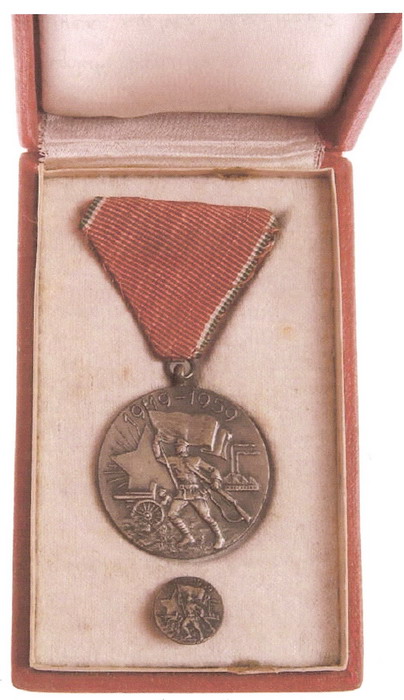
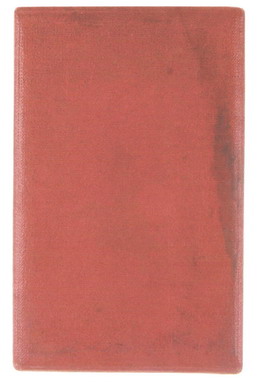



 0
0 -
Ulsterman,
Here is your medal in the case. Since it is a civilian award it is in a blue case. I am afraid it will be some time before I/we get to Blood Donor medals. Both of us have a number of projects in the works. Sounds like an interesting challenge though!
Regards,
Gordon
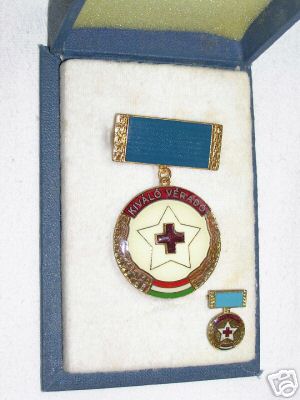
 0
0 -
Ulsterman,
Farcas is in Hungary. As far as I know he is the co-owner of Atlant-Hungary Airline Company.
Cheers,
Gordon
0 -
The picture of the Cosmonauts visit to Budapest.

 0
0 -
Soyus-36 - The joint Russian Hungarian space flight
Within the framework of Intercosmos co-operation it was possible for member countries (socialist countries) to send a cosmonaut into space. The task of selecting the Hungarian cosmonauts began in May of 1977. The selection was made from the pilots at the aviation Medicine Research Centre at Kecskem?t. Eventually, after a series of tests, a short list of four was achieved. This list was eventually reduced to two names: Bertelan (Bertsi) Farkas and Bela Magyari. They were sent to the Soviet Union to prepare with their Soviet colleagues at the Gagarin Space Centre. Both men completed all of the training and it was only a few hours before the launch that the final decision was made as to who would be the primary and who the member of the backup crew. Bertelan Farkas was chosen as the primary crew member and the Russian crew member would be Valeri Nikolayevich Kubasov. Kubasov was the Commander and Farkas the Research Cosmonaut. Vladimir Alexandrovich Dzhanibekov was the commander for the backup crew while B?la Magjari was the Research Cosmonaut. The call sign for the primary crew was ?ORION?.
The original launch date for the ninth expedition to Salyut 6 was to have been June 1979 on Soyuz 33. It was postponed after the Soyuz 33 main engine failed. Kubasov and Farkas eventually blasted off from launch pad 31 of the Baikenur space centre aboard Soyuz 36 on July 31, 1980. The duration of the flight was 7 days 20 hours and 45 minutes. They docked with the Salyut Space Station and relieved the crew of Gorbatko and Pham (North Vietnam) who returned to earth. The Hungarian mission was the fifth in the Intercosmos programme.
During the eight days they were aboard Solyut 6 they carried out twelve Hungarian prepared scientific research experiments in material processing, earth observation, and life sciences. The best known research experiment was on interferon. Farkas had special Hungarian prepared foods with Hungarian tastes in a special dried tube form. Farkas and Kubasov returned to earth on June the 3rd, landing 140 Kms southeast of Dzeskasgan.
As a side note, if one had to travel into space with another person Valeri Kubasov seems to be the ideal choice. By all accounts he was a lucky man who escaped death twice in the Soviet space program. He was part of the crew that was originally intended to fly Soyuz 2, which was found to have the same faulty parachute sensor that resulted in the death of Vladimir Komarov on Soyuz 1. Soyuz 2 was eventually launched without a crew. Slated for a subsequent mission on Soyuz 11 he was grounded for medical reasons. The back-up crew on that mission was killed when the capsule was accidentally depressurized by a faulty valve. Kubasov was also a member of the Soyuz 6 and 19 crews. Before he retired in 1993 he worked in the development of the MIR space station.
Farkas was a hero after his space flight. In 1986 he graduated from the Faculty of Transport Engineering of the Technical University of Budapest. From 1986 he worked within the research group of the Intercosmos Council of Hungarian Academy of Sciences. In 1995 he was promoted to Brigadier General as the Deputy Flight Observer of the Hungarian Army. In 1996 and 1997 he served as Military Attache to the United States. He retired in 1997.
There are two badges, that I am aware of, that Hungary produced to commemorate the flight of Soyuz 36. The first one I will post a picture of is a small 20mm blue badge bearing the legend K?Z?S ?RREP?LES-1979 (JOINT SPACE FLIGHT-1979). The badge also shows part of the earth as viewed from space with the Russian and Hungarian flags in the centre. Above the earth is the Salyut 6. The inscription on the badge must have caused some discomfort for the Hungarian government, considering the actual launch date of Soyuz 36, and I do not know if they were actually handed out but they certainly are available now although not in large numbers.
The second badge is a oval one 60mm in width, at its widest point, and has two screws on the back. The background of the badge is medium blue with a light blue globe in the centre representing the earth. A red rocket is shown circling the earth before heading off into space. The Hungarian State crest is pictured at the bottom of the globe. The caption at the bottom of the badge reads; A MAGYAR N?PK?ZT?RSASAG ?RHAJ?SA (THE HUNGARIAN PEOPLE?S REPUBLIC COSMONAUT). It was issued only to those who could actually participated in the Intercosmos joint flight of Soyuz36/Salyut-6; Bertelan Farkas and his back-up cosmonaut Bela Magyari. The badges were not circulated or sold to the general public. The badge pictured is in a private collection and negotiations to move it from its present location into my collection have proven unsuccessful.
Following the badges is a picture taken somewhere in Budapest after the return of the cosmonauts. Bertalan Farkas is in the centre wearing the oval badge pictured below over the right breast pocket of his uniform. On the right breast pocket of his uniform he wears the Hungarian Parachutists ?Free Fall Badge?. The highest level of parachute qualification in the Hungarian armed forces at that time. I can not tell from the photo what award is worn above the space flight badge. On his left side, above the ribbon bar, are the Hero of the Hungarian Peoples Republic and beside it the Hero of the Soviet Union. Pinned to his left lapel, on a Soviet style ribbon, is an award I do not recognize. Bela Magyari is following him and wears the Flag Order of the People?s Republic of Hungary on the left upper pocket of his uniform. Unfortunately, the photograph is not clear enough for us to be able to identify the class of the award. Kubasov is in civilian clothes to Farkas?s right. Kubasov is also wearing the Hero of the Hungarian People?s Republic on the lapel of his sport coat.
The badges;
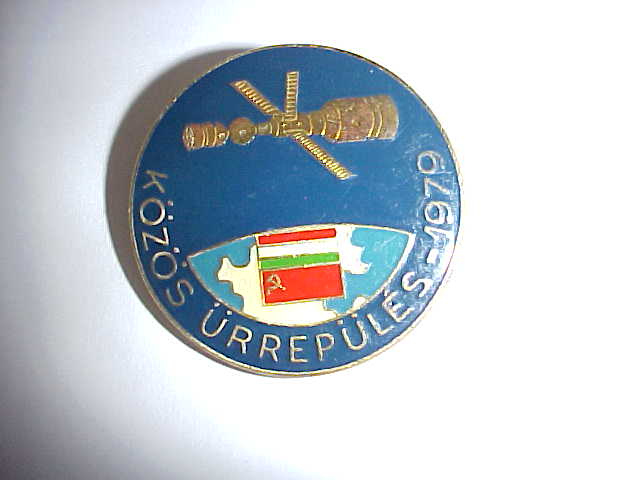
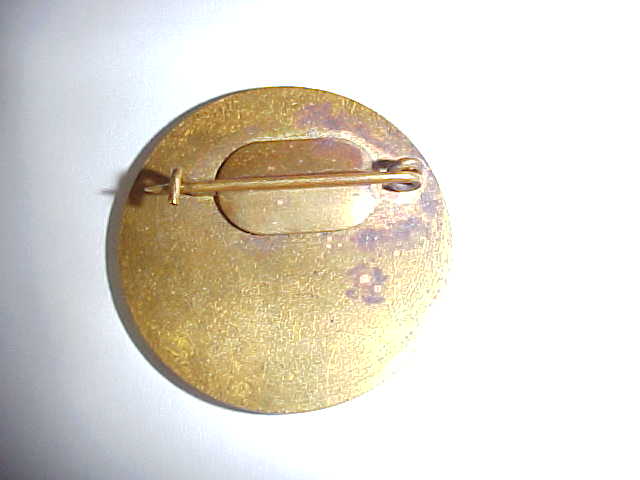
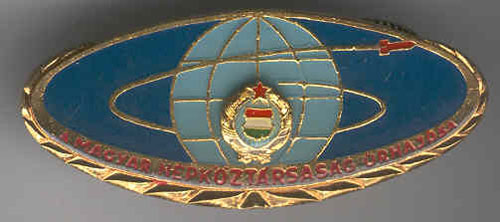


 0
0 -
Kevin,
Thanks for the offer to lok up the U shaped badge. I am familiar with the I shaped Austrian sub. I was curious about the ushaped badge I posetd because of the flag. Unfortunatley I can not see what is printed on the flag in the picture in the book. Here is a scan of another U shaped badge in commemoration of an event. It is from the same period as the other U shaped badge.
Regards,
Gordon
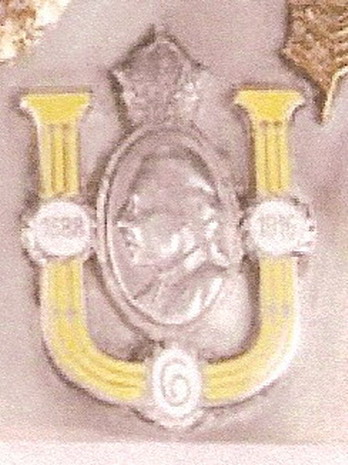
 0
0 -
haynau,
Thanks for the info on the Bulgarian Red Cross badge. Your explanation of getting one for a donation to the Red Cross fits in with Kevin's post on the "tinnies" that were also worn on the hat. I guess I'll just have to wait on IDing the U shaped badge. Some time in the future someone will probably read this thread and post the answer. Is happened to me before!
Regards,
Gordon
0




Hungarian "Death Squad" Arrow Cross Brassard
in Central & Eastern European States
Posted
Mike,
Ah yes, Snider's Treasures". What an unusual chap! The arm band you mentioned could have been one of just a few made although from the sounds of it well made. I don't ever remember reading about anyone rounding up people after Operation Margarethe who wasn't wearing a black Arrow Cross uniform but then again there isn't a lot in print about them. The arrow cross stamps on documents awarding medals etc were certainly removed at the end of the war. I saw an award document for a Vitez at the December Militaria Show here in Budapest and in the location where the authorization stamp is normally placed there was just a neat round hole. Hopefully I will get to visit The House of Terror soon. My wife even mentioned visiting it this morning at breakfast! Strange coincidence?
Just as an illustration of things that happened re the Arrow Cross in the last few months of the war, here is a picture of the Arrow Cross stamp that the Vannay Battalion used to authenticate their documents with the Arrow Cross. It wasn't an official stamp because there wern't any so they engraved their own. The photo is from Ervin Galantay's book "Boy Soldier".
Regards,
Gordon